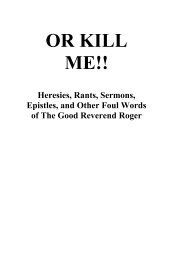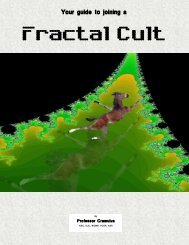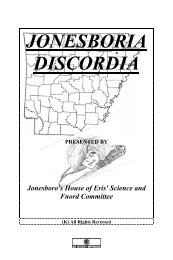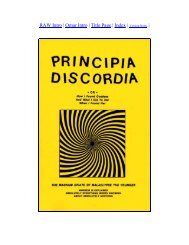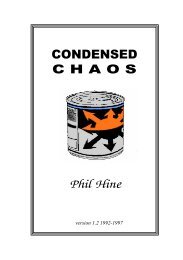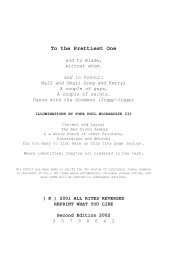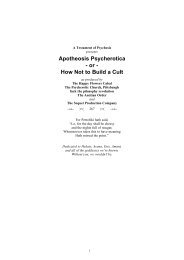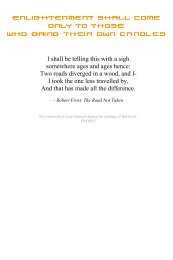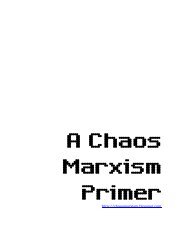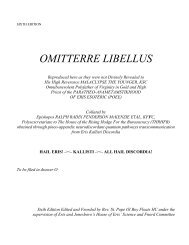Coincidance - Principia Discordia
Coincidance - Principia Discordia
Coincidance - Principia Discordia
You also want an ePaper? Increase the reach of your titles
YUMPU automatically turns print PDFs into web optimized ePapers that Google loves.
COINCIDANCE 159<br />
in Alice in Wonderland but was originally published under the title "Mishmosh."<br />
(Nor avoice from afire belowsed mishe tnishe...)<br />
Alice first appears with the initials ALP and her family name, Liddell, on<br />
the second page of FW<br />
he addle liddle phifie annie (emphasis added)<br />
She recurs hundreds of times, and is even in the famous prankquean<br />
riddle, "Why do I am alook alike a poss of porterpease?" Alike is Greek for<br />
Alice, and "like as two peas in a pod" suggests the warring twins ( )<br />
again, while "I am" brings us back to the E at Delphi and the voice from a fire<br />
that bellowed Moishe Moishe and then identified itself as I AM.<br />
Coincidentally, Dodgson invented the mathematical symbol , which<br />
Joyce uses for nonlocal consciousness. {Of course on the E or ego level, "why<br />
do I am alook alike a poss of porterpeece" just echoes customers in<br />
Earwicker's pub calling for a pint of porter, please.)<br />
Charles Dodgson, the rationalist-mathematician, and "Lewis Carroll" the<br />
fantasist and child-lover, are often presented as one of Joyce's Jekyll-Hyde or<br />
split man teams ( ) but on one occasion they get expanded into a full<br />
triplicity or system: "Dogfather, Dogson and Coo," which sounds<br />
like a British partnership company but invokes the Holy Trinity—Father,<br />
Son and Pigeon. We are back at the Pigeon House again, where Stephen<br />
Dedalus thought of Mary's bizarre sexual coupling with the Pigeon and<br />
Bloom masturbated while virginal Gerry McDowell exhibited her bloomers<br />
(a verbal synchronicity). After the "immaculate" (no touching) sexual<br />
encounter of Gerty and Bloom, Bloom wrote in the sand, I AM A — and<br />
stopped. We will never know if he was going to write A VOYEUR, in<br />
shameful confession, or ALONE, in anguish (or maybe even A JEW in<br />
defiance?) In any case, he accidentally wrote "I am aleph" in Hebrew or "I am<br />
alpha" in Greek and thus invoked Revelations 1:11, "I am alpha and omega, the<br />
first and the last, saith the Lord." This 1:11 business turns out to be more<br />
curious than we realize at first, even if we note that it is connected with<br />
Bloom's son, who died at age 11 days, Shakespeare's son Hamnet who died<br />
at 11 years and the 22 (2x11) letters in the Hebrew alphabet or the 22 words<br />
in the first sentence of Ulysses.<br />
If ALP and APL invoke all this, the LAP, a further permutation, invokes<br />
the LAP where a Freemason wears his apron, as in Aleister Crowley's<br />
BOOK OF UES, Chapter 54, in which some Freemasons guess that the lost<br />
Mason Word is AMO, whose number is 111, and some guess that it is LAP<br />
which also has the number 111. (By Cabala, AMO=A which is 1, M which is<br />
40, and O which is 70,1+40+70=111, while LAP=L or 30, A or 1, and P or 80,<br />
and 30+1+80 also=lll.) William York Tindall, a Joyce scholar who likes to<br />
count, has noted that many of the long sentences in FW have 111 clauses.



